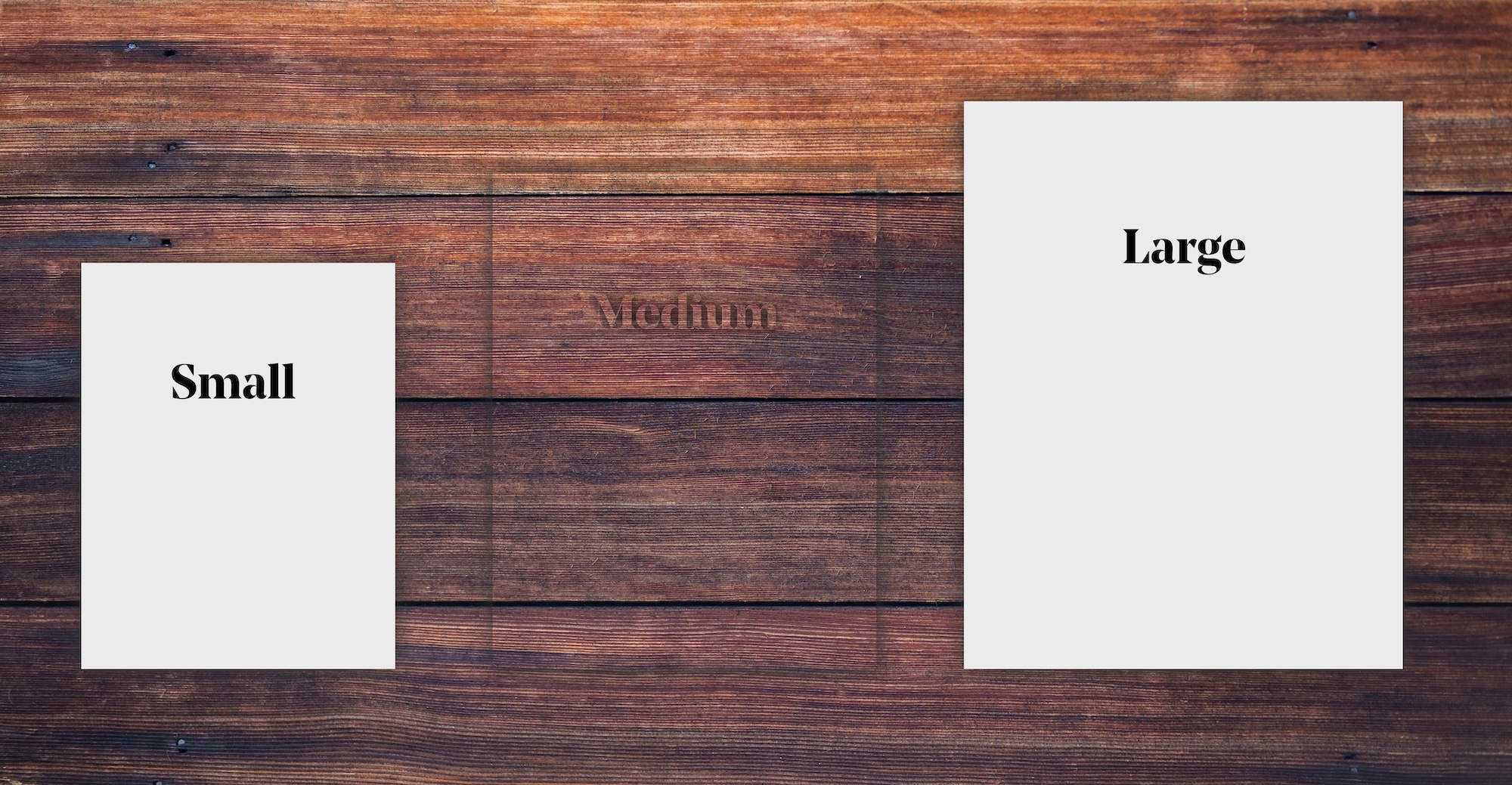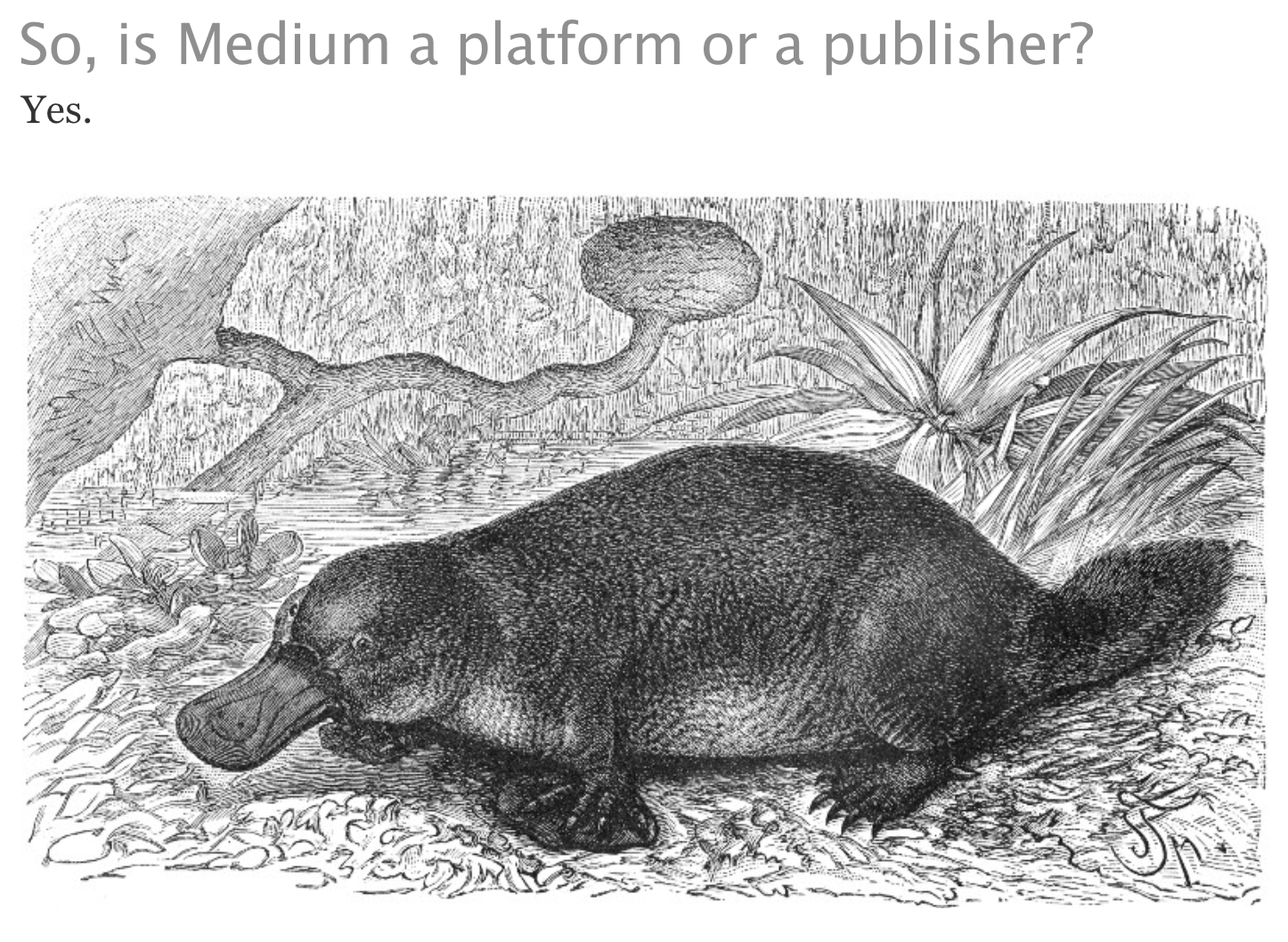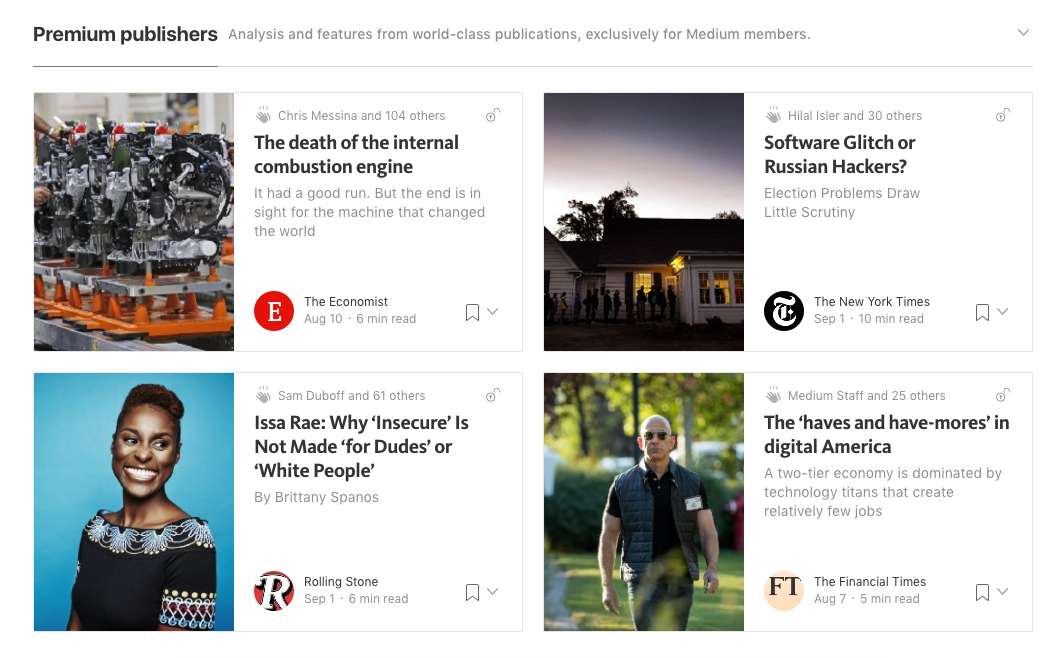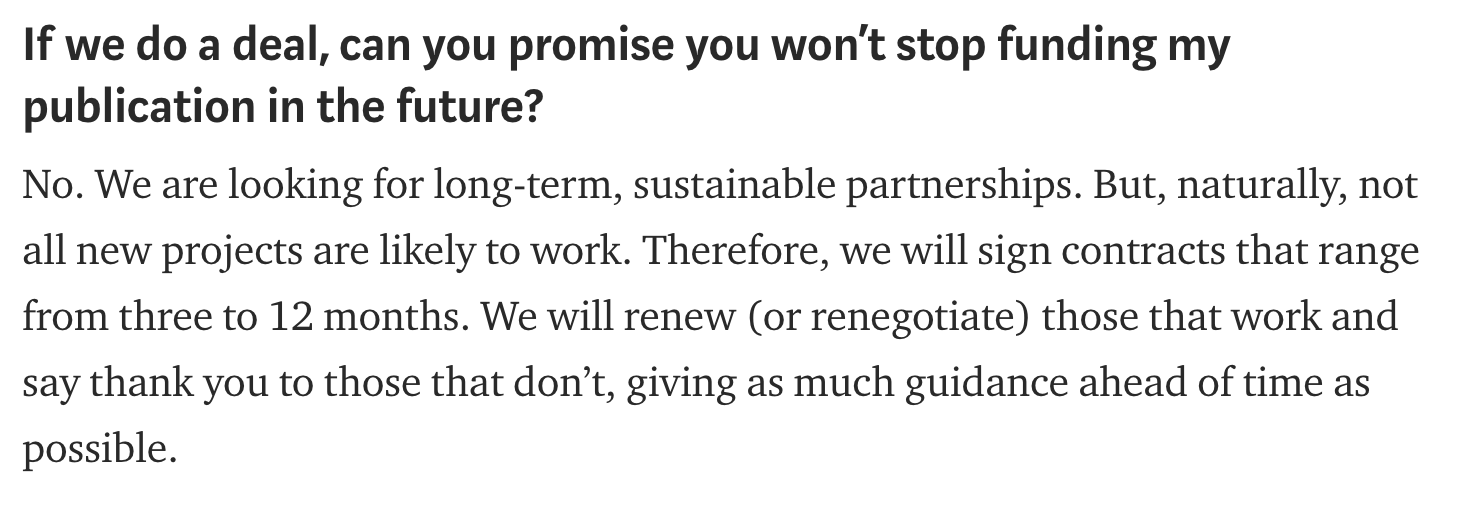
Fool me once, shame on you. Fool you twice, shame on me. Fool me seven times, well…how much money do you have, again?
Less than a year after Medium abruptly canceled the membership programs of its remaining publishing partners, the company is coming back around like an ex promising you they’ve changed. “We are seeking partners to create new publications on Medium, which we will help fund and distribute,” it said in a blog post Tuesday.
It’s not the first time, of course. Medium is nearly seven years old. It’s raised $132 million in venture funding, and it is not profitable. It has undergone countless pivots. When I saw that new search for “partners” last week, I started trying to count how many — and then ended up documenting the history of Medium via articles and tweets and Ev Williams statements.1 Why do that? I don’t know. I guess I was trying to figure the company out in my own head.
Medium made it possible for anyone to blog and be seen. On August 14, 2012, when Ev Williams publicly launched Medium, he wrote, “On Medium, you can contribute often or just once in a blue moon, without the commitment of a blog. And either way, you’re publishing into a thriving, pulsing network — not a standalone web site, which you alone are responsible for keeping alive.” Today, that’s still true and is arguably the best thing about Medium. This year, for instance, Jeff Bezos used Medium to reveal the National Enquirer’s efforts to blackmail him. Bezos might have used something else if Medium didn’t exist, but it does seem as if some of the very early hopes that the platform would democratize blogging has been achieve. Other noteworthy posts that might not have gotten nearly as much traction if they hadn’t been published on Medium (and that might not have even been written if Medium hadn’t existed) include James Bridle’s 2017 investigation into YouTube kids’ videos, “I made the pizza cinnamon rolls from Mario Batali’s sexual misconduct apology letter,” “When the racist is someone you know and love,” and “Living and dying on Airbnb.” And please never forget “Just checking in.”
But Medium has also done a number of not-so-great things. It’s sometimes been called a “YouTube for text,” but unlike YouTube, there are no Medium-native stars. Rather, the company has typically hired and promoted the work of editors and writers who were already well known. Many of them were able to head back to legacy publications or other ventures when their Medium publications folded; people whose careers weren’t as established, or who were starting publications on Medium from scratch, often haven’t been so lucky. And partnering with Medium arguably hastened the decline of some beloved sites (R.I.P. The Awl).
How much does that matter? (On a large scale — it obviously matters a lot to the individual people whose careers have been affected.) Even if Medium never raises more money from VCs, Williams’ personal wealth hovers in the wings as a possible savior — if not to the entire publishing industry (definitely not), then maybe to some individual publication. If not to some individual publication (probably not), then maybe to an individual writer or two. That promise of not-totally-evil money has kept people coming back, pulling new writers and editors in when the old, disillusioned ones leave or get kicked out. The promise of cash and the freedom to write what you’re passionate about has always been there, because Williams — who truly seems to hold an idealistic vision of what Medium could be — has never stopped promising it (well, except for a brief weird period in 2015 when he tried to reframe Medium as a kind of social network). One big thing that sets Medium apart from other unsuccessful media ventures is that its flow of money has never been completely shut off.
I want to be clear: I don’t blame people who go do something for Medium. Seriously, grab that money while it’s there. In 2015, after I was laid off, I talked to people at Medium about starting a parenting publication there. It was something that I might have received a few thousand dollars to do. I joined Nieman Lab instead, but that freedom (?) and potential money still float in and out of my mind. Some of the news stories I’ve written about Medium have been too credulous; I’ve taken too much of Williams’ startup speak at face value. I (and many others) devoted what now seems like way too much mental energy to the “Is Medium a platform or a publisher?” question. Sure, Williams’ frequently shifting stated vision didn’t help, but that angst still feels ridiculously quaint in 2019.
Why spend so much time worrying about what Medium is? Maybe because we wanted to know whether it was a friend or an enemy. The answer is that it’s neither. It’s a reflection of what the media industry has worried about, and hoped for, and not received. But Medium was never something that we would get to define. Instead, it’s turned out to be an endless thought experiment into what publishing on the internet could look like. That’s not much fun for people who got burned along the way, but Medium was never exactly ours to begin with.
The space Medium occupies stands between two poles. On one side, you’ve got people who want to hang out a shingle online and own their work in every possible sense. On the other, you’ve got people who are happy in the friendly confines of Facebook and Twitter, places where they can reach their friends effortlessly and not worry about writing elegant prose. Is there an audience between those two poles that’s big enough to build something lasting?
It’s an internet where every blog is Daring Fireball, where every post looks like Instapaper, where every discussion is led by its rightful leaders, and where ads are considered no better than spam. It’s barren but design-forward, and, at least at the moment, kind of elitist. It’s not clear how it’ll make money. Maybe it won’t! Maybe that’s part of the idea.
Producing a “feed” subsumed in the apps of our time is not a business. It might (SORRY) own the means of its production but it won’t own the means of its revenue.
Except, of course, they all do have an interest in being a business. Or will. It’s great to build a fun product! But it’s not like people are going to spend millions on making something and have it be a happy write-off in three years.
Kate’s job is to help get great stuff onto Medium. She’ll do this in a variety of ways — by discovering, encouraging, soliciting, commissioning, and contextualizing interesting ideas, authors, and institutions. She’ll do this from New York — home of so many of the world’s best storytellers. And she’ll be building a small team to help her.
Log in, and you’ll be greeted with a diverse mix of content: a picture of birds in the snow, a love story, and a first-hand account of donating a bag of cash at Planned Parenthood dressed as a cat burglar. I enjoyed the stuff I read more than I expected to, although it’s hard to say whether that was because of Medium’s secret sauce or because the early adopters are already good writers.
However, there’s no hard evidence of demand for the kind of things Medium offers. People definitely want to read news online, and they definitely want to see their friends’ updates on Instagram, and they definitely want Harry Potter fan fiction. But do they want random anecdotes and backyard photos from strangers?
It’s a smart bet to watch what this team does because of its experience, but also because they are in a mode of taking their time and seeing what works. Whenever you see a well-established team, much like Path, taking its time to make beautiful things, you simply have to take notice. They are the most dangerous when it comes to disruption.
There are lots of questions about whether Medium is responsible (especially in this invite-only phase) for its posts. Medium takes the opportunity to insist that it is a platform.
@kouroshk Medium needs to decide if it's a platform or media company; if the latter it should take some responsibility @declanm @Medium
— Dan Gillmor (@dangillmor) August 2, 2013
@dangillmor @kouroshk @declanm @Medium we're in the platform side of things for now. thousands of users, can't scale editorial control
— Evan Hansen (@evnhsn) August 2, 2013
@dangillmor @kouroshk @declanm We are a platform. Any changes to an article are up to the author.
— Medium (@Medium) August 2, 2013
Hamish McKenzie, then at PandoDaily (now founder of Substack), writes:
Medium has some clearing up to do. It needs to get the message across that even though it sometimes appears to endorse some content — by promoting the posts, juicing their distribution, and, in some cases, even paying the writers — that doesn’t mean it is vouching for its veracity. It would help, also, if the company tweaked the titles of its editorial team so it was clear that those people are responsible for direction and curation rather than actual copy-wrangling. And it should more clearly explain how Matter fits into the overall scheme of things.
What are the boundaries and limits of Medium? If anything defines a publication, it is what it *doesn’t* do. More specifically: is Medium a place where Peter Shih should post about San Francisco women he thinks are ugly? Is Medium a better place on the Internet or is it any old place on the Internet?
Medium could have ‘certified content’, that which has been fact-checked and signed off by an editor, and advertise it as such at the top of the page. The rest would be uncertified pieces, marked as such too, which would raise readers’ own fact-checking radars and distance the editorialized content from Medium.
But no doubt that uncertified content will continue causing problems. Now, misinformation, no matter the source, can get around the world a hundred times before the truth even finds its shoes.
Medium matters because it helps to define whether great writing finds a sustainable expression on the web in the post-banner-ad era. Medium matters because it pushes blogging, the native medium of the web, to a new stage of evolution after a decade of relative stagnation.
“Reading the news doesn’t make us any smarter,” writes product lead Pete Davies.
[Williams] wants to see better journalism emerge on the issue of climate change, asserting that views have been manipulated by an avalanche of lies coursing through the Internet. But what’s to say that a mathematically mediated site — basing quality on reader attention — will elicit the truth?
Looking at Medium, along with Vox, and Glam, and even AOL, I think I can begin to discern the vague outlines of how digital publishing might eventually be able to deliver the kind of scale and impact that brand advertisers demand from TV and glossy magazines.

If “platishers” takes off, I will never forgive anyone involved in this article http://t.co/eHDm9aFW3r
— Joshua Benton (@jbenton) February 7, 2014
platisher is the worst new word of all time. let's fix this Twitter. publiplat. publiform. platipub. platypub. http://t.co/soKczuHZCk
— Evan Hansen (@evnhsn) February 7, 2014
Now medium is GOOD software, but it's not a good deal for writers. That should be part of every analysis of medium, but they leave that out.
— scripting.com (@davewiner) May 26, 2014
Over time, Milikan writes, she came to think of Medium as
the Cowbird, a brood parasitic cuckoo that lays its eggs in the nests of other birds when they are away. The host mother bird unknowingly nests the foreign eggs and, when they hatch, the cowbird chicks consume an inordinate amount of resources, diverting them away from the native chicks.
The best sign Medium is YouTube for text: contributors quitting over discovery and rev share! https://t.co/RFo0yeqA4q
— Casey Newton (@CaseyNewton) May 31, 2014
"Medium is unquestionably a platform…One of the publishers on the platform is Medium, the company" https://t.co/vKRzy5q9on
— Laura Hazard Owen (@laurahazardowen) June 9, 2014
“Mr. Levy’s hiring suggests that what has been a platform is also beginning to look more and more like a publisher,” David Carr writes, “albeit one with no revenues and no business model to date.”
Medium is a for-profit entity. Definitely we will make money…The sooner we get money flowing through the system and allow other people to make money, that drives more professional content. That’s not necessarily our business model for the whole thing, but it is useful now to drive more good stuff.
Everything on the Internet is the Same, Vol. 3490832: Medium sounds a little bit like Twitter now. https://t.co/bkh9u7N5ZX
— Rachel Damgen (@racheldamgen) February 24, 2015

Steven Levy publishes Medium’s first quiz.

It turns out @ev's third act was to make Steven Levy write an online quiz. Huh. http://t.co/HC33FYUax3 https://t.co/pXWeY6cqPB
— Ryan Tate (@ryantate) May 22, 2015
Saul Carlin, Medium’s head of publisher development, writes, “We’re starting to develop new native advertising solutions and paid content models that we think will help professional writers, bloggers, and publishers earn revenue on Medium.”
Williams notes that in the past few months, “over 100 sites moved to or launched on Medium under a custom domain.”
“Done right, you get many of the benefits of placing an op-ed without any of the hassles,” says Matt Lira, a digital strategist with House Majority Leader Kevin McCarthy, who published an Oct. 22 piece on Medium about El Niño and the California drought. “Medium has done a great job making the platform look incredibly professional for people with zero technical ability.”
We eliminate the need for any investment in tech, provide access to a growing network oriented towards meaningful engagement, and deliver constant, always-on innovation from a world-class product development team, whether you’re a single blogger or a large commercial publication — all for free.
The publications were always an opportunity for us to learn more about our platform, as well as to rolemodel what other publications can do, and they’ve been super helpful in that. In talking to The Ringer and others, having these professional publications on the platform helped a lot in making those deals.
But long-term it’s clearer and clearer I think to the world that Medium really is a platform, and there may be flagship publications that we own, but that’s not the gist of it. For now, nothing has changed about Backchannel.
Did Williams tell the editors and writers he hired to launch and run Medium publications that they were lab rats?
— Adam L. Penenberg (@Penenberg) March 25, 2016
The Awl and The Hairpin, Electric Literature, Pacific Standard, The Black List, Femsplain, Monday Note, and NewCo Shift will migrate their content to the platform, and will all take on a Medium-ish look. “Medium is offering a tremendous suite of services that makes sense for where we are right now,” The Awl Network publisher Michael Macher tells Digiday. “This extra network effect is extremely positive. Being on Medium makes the process more efficient, and from an aesthetic point of view, it’s a good place for it to live.”
Unless it is a CMS you can download & own, Medium For Publisher is not worth is. https://t.co/AvbQ4TKhJL pic.twitter.com/Ne6ixWpsqN
— Rafat Ali, Media Operator (@rafat) April 8, 2016
“It’s a simplistic view to say go where the people are,” Williams says at the event. “You need to go where the right people are.”
“We used to work in a place where everything was controlled under one roof, but it doesn’t make a lot of sense unless you’re one of the massive players left, and I don’t know that there are going to be that many of them standing in a couple years,” says Nicholas Jackson, then Pacific Standard’s editor-in-chief. “Who do you expect to make it?”
“In building out this model, we realized we didn’t yet have the right solution to the big question of driving payment for quality content,” he writes, adding, “it’s clear that the broken system is ad-driven media on the internet.” Medium is ending its involvement with ads. “We are shifting our resources and attention to defining a new model for writers and creators to be rewarded, based on the value they’re creating for people.”
It’s unclear what will happen to Medium’s publishing partners. “I certainly doubt the in-network ad revenue will reach the levels that they originally projected,” Electric Literature’s Andy Hunter tells us. Another publisher, The Establishment, is left in the lurch:
Our launch day, today, was scheduled in early December. We received news of Medium’s pivot and attendant downsizing when the rest of the world did, around noon.
At this time, this is, literally, all we know.
Elizabeth Spiers, another one of Medium’s publishing partners, writes:
Now Medium is shutting down its publisher program, which is sort of unexpected given that (in my opinion) they had mostly opted for traditional ad sales for monetization, which is what they were theoretically going to find an alternative to. So I respect Ev, and believe that being proactive when there’s a problem is important, but I’ll admit I’m baffled when the stated rationale for throwing in the towel is that ad-backed media is broken. If we agree that it is, it was broken when Medium began the publisher program, and had they listened to any people who’ve been publishers before (many of the publishers in their revenue program, for example), that would have been obvious.
.@DrawMark in our newsletter https://t.co/c88eozdxih pic.twitter.com/aG00SyuE0g
— The Nib (@thenib) January 6, 2017
A former employee: “Ev is not that interested in revenue, to be honest. He’s driven by wanting to create this democratic space for people to have a voice, for the best content to rise on top. The problem that does not excite him is ‘How do I make money?’ And he has the luxury in doing that.”
This…is a pretty vague pitch. More “support the cause” than “purchase the product” https://t.co/Iq3ggJfiT3
— Joshua Benton (@jbenton) March 22, 2017
I think @ev's plan would be fine if Medium were @Longreads, but Medium isn't Longreads. Medium is a venture-funded *platform* https://t.co/NQlfiFv7xs
— 🤖 Sonya Mann 🎀 (@sonyaellenmann) March 23, 2017
“Media is broken,” Williams writes. “And we need to fix it.”
Right now, we’re very concerned about the future of our site’s partnership with Medium. What we were sold when we joined their platform is very different from what they’re offering as a way forward. It’s almost as if Ev Williams wasn’t concerned that he was pulling out the rug from underneath publishers who had placed their trust in his vision for the future of journalism.
"Jerking around publishers until you find something that works" seems like a flawed business model. https://t.co/CId39rU4Ld
— Will Oremus (@WillOremus) March 24, 2017
Previously, if people wanted to get paid, we were working with them individually, accepting pitches, going back and forth doing light editing, signing contracts in a more traditional way and paying them on those terms. The big change, essentially, is that once they’re in the program, people can publish themselves and get paid on performance.
It’s a dramatic change, but it was always our plan to figure out how to do this.
Owen: Where is the money to pay the writers coming from? Is it coming from you, Medium the company, or is it coming from readers?
Williams: Well, it’s a little bit of an arbitrary distinction because all the money comes to us, and we are paying out the money. The budget will be pegged to the subscription revenue because it needs to be. We can’t pay out of pocket for all the writing. We will pay writers from the subscription revenue.
Owen: But, I mean, is Medium the company contributing money to the writers directly as well?
Williams: Like any marketplace, we are going to seed it first. Usually, you need to seed supply before you have enough demand, so there’s something for people to come to. In the beginning stages, we’re not limiting the payouts to subscribers. We are investing more than the current amount of subscriber revenue to seed the market.
Owen: What’ll be the point you have to get to where all of the money is coming from the readers? When can you stop seeding it?
Williams: It’s pretty hard to predict. I look at it this way: If you compare the monetization from the subscription product to a web-based ad product, even at our relatively small price of $5 a month, subscription is a phenomenally better monetization model for a reader. Therefore, there is a lot more money for the content that is engaged with than the content that is available to pay writers from an ad-driven model. So for those who do well in the program, there’s every reason to expect that they can make more money writing here than they could at an ad-based publication.

Ev Williams is trying to brute force his way through the problem of publishing and monetization. In doing so, he has upended people’s lives — he has upended good publications. I understand the desire to be agile and to pivot, and to try new things when things aren’t working. But it’s destructive — you can’t try people and things on, then discard them. It’s not how a media company or a publishing company can work.
Williams to BuzzFeed: “What I’m trying to make clear is that it was never the strategy to become publishers ourselves.”
Medium spokesperson to BuzzFeed: “People have always tried to define us based on outdated buzzwords, while we are focused on building a new, modern model that works.”
Basically every writer/cartoonist I know has had their life ruined by Medium at some point but sure 5th pivot's a charm https://t.co/iDMJQGDYHW
— Jaya Saxena (@jayasax) May 9, 2018
this is the FOURTH time medium has staked a round of new publications on its platform and killed them in a year or less
— Casey Johnston (@caseyjohnston) May 10, 2018
.@ElectricLit is facing a $25,000 loss of contributed income because of Medium's latest "pivot." If you'd like to support our mission to make literature exciting, accessible, and inclusive, we've moved our membership program to @drip. https://t.co/h6mnRTATDO
— Halimah Marcus (@HalimahMarcus) May 9, 2018
Can Ev Williams please just stop fixing the internet? https://t.co/vyPBYvZbTMhttps://t.co/ModqLI9qNl
— Alex Heath (@alexeheath) May 10, 2018
A tech pub on @medium? Great idea!
— Steven Levy (@StevenLevy) March 15, 2019
It doesn't affect compensation—assuming you mean for Partner Program. That's determined by readership from paying members, which will still be counted (assuming they're logged in).
— Ev (@ev) February 27, 2019
We will certainly watch that, and if it has a negative impact, we may change this in the future. As it stands, Twitter is a relatively small (but important) part of our traffic, and we expect this to have a positive effect.
— Ev (@ev) February 27, 2019

“If I dropped dead tomorrow,” Bittman says, “is there something we’ve done that can last?”